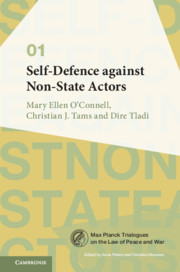82 results
Psychotropic medicines’ prevalence, patterns and effects on cognitive and physical function in older adults with intellectual disability in Ireland: longitudinal cohort study, 2009–2020
-
- Journal:
- BJPsych Open / Volume 10 / Issue 2 / March 2024
- Published online by Cambridge University Press:
- 01 February 2024, e39
-
- Article
-
- You have access
- Open access
- HTML
- Export citation
Pathways to the medieval hospital: collective osteobiographies of poverty and charity
- Part of
-
- Article
-
- You have access
- Open access
- HTML
- Export citation
Banning Autonomous Weapons: A Legal and Ethical Mandate
-
- Journal:
- Ethics & International Affairs / Volume 37 / Issue 3 / Fall 2023
- Published online by Cambridge University Press:
- 01 December 2023, pp. 287-298
-
- Article
-
- You have access
- Open access
- HTML
- Export citation
Association between socioeconomic deprivation and incidence of infectious intestinal disease by pathogen and linked transmission route: An ecological analysis in the UK
-
- Journal:
- Epidemiology & Infection / Volume 151 / 2023
- Published online by Cambridge University Press:
- 14 June 2023, e109
-
- Article
-
- You have access
- Open access
- HTML
- Export citation
The effect of vitamin D supplementation on pain: an analysis of data from the D-Health randomised controlled trial
-
- Journal:
- British Journal of Nutrition / Volume 130 / Issue 4 / 28 August 2023
- Published online by Cambridge University Press:
- 25 November 2022, pp. 633-640
- Print publication:
- 28 August 2023
-
- Article
-
- You have access
- Open access
- HTML
- Export citation
Monitoring Prisons in Europe: Understanding Perspectives of People in Prison and Prison Staff
-
- Journal:
- Law & Social Inquiry / Volume 48 / Issue 1 / February 2023
- Published online by Cambridge University Press:
- 24 March 2022, pp. 205-235
- Print publication:
- February 2023
-
- Article
-
- You have access
- Open access
- HTML
- Export citation
Association of Ventilation during Initial Trauma Resuscitation for Traumatic Brain Injury and Post-Traumatic Outcomes: A Systematic Review
-
- Journal:
- Prehospital and Disaster Medicine / Volume 36 / Issue 4 / August 2021
- Published online by Cambridge University Press:
- 31 May 2021, pp. 460-465
- Print publication:
- August 2021
-
- Article
- Export citation
Chapter 5 - Byron and His Publishers
- from Part I - Life and Works
-
-
- Book:
- Byron in Context
- Published online:
- 04 October 2019
- Print publication:
- 05 December 2019, pp 46-52
-
- Chapter
- Export citation
10 - Reestablishing the Rule of Law as National Security
- from Part III - The Future Imagined
-
-
- Book:
- Reimagining the National Security State
- Published online:
- 25 October 2019
- Print publication:
- 07 November 2019, pp 154-168
-
- Chapter
- Export citation
Index
-
- Book:
- Self-Defence against Non-State Actors
- Published online:
- 29 July 2019
- Print publication:
- 01 August 2019, pp 282-286
-
- Chapter
- Export citation
3 - Self-Defence, Pernicious Doctrines, Peremptory Norms
-
-
- Book:
- Self-Defence against Non-State Actors
- Published online:
- 29 July 2019
- Print publication:
- 01 August 2019, pp 174-257
-
- Chapter
- Export citation
Copyright page
-
- Book:
- Self-Defence against Non-State Actors
- Published online:
- 29 July 2019
- Print publication:
- 01 August 2019, pp vi-vi
-
- Chapter
- Export citation
Contents
-
- Book:
- Self-Defence against Non-State Actors
- Published online:
- 29 July 2019
- Print publication:
- 01 August 2019, pp vii-x
-
- Chapter
- Export citation

Self-Defence against Non-State Actors
-
- Published online:
- 29 July 2019
- Print publication:
- 01 August 2019
1 - Revitalizing the Theory of International Law Compliance
-
- Book:
- The Art of Law in the International Community
- Published online:
- 14 May 2019
- Print publication:
- 16 May 2019, pp 17-50
-
- Chapter
- Export citation
Conclusion
-
- Book:
- The Art of Law in the International Community
- Published online:
- 14 May 2019
- Print publication:
- 16 May 2019, pp 296-305
-
- Chapter
- Export citation
6 - Revitalizing the Process of International Dispute Resolution
-
- Book:
- The Art of Law in the International Community
- Published online:
- 14 May 2019
- Print publication:
- 16 May 2019, pp 259-295
-
- Chapter
- Export citation
Copyright page
-
- Book:
- The Art of Law in the International Community
- Published online:
- 14 May 2019
- Print publication:
- 16 May 2019, pp iv-iv
-
- Chapter
- Export citation
Dedication
-
- Book:
- The Art of Law in the International Community
- Published online:
- 14 May 2019
- Print publication:
- 16 May 2019, pp v-vi
-
- Chapter
- Export citation
Contents
-
- Book:
- The Art of Law in the International Community
- Published online:
- 14 May 2019
- Print publication:
- 16 May 2019, pp vii-viii
-
- Chapter
- Export citation

